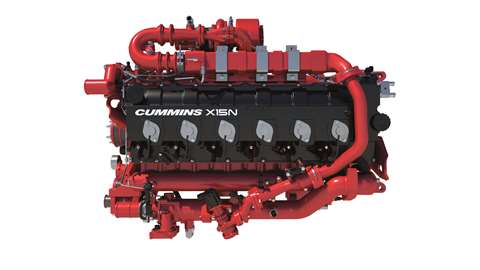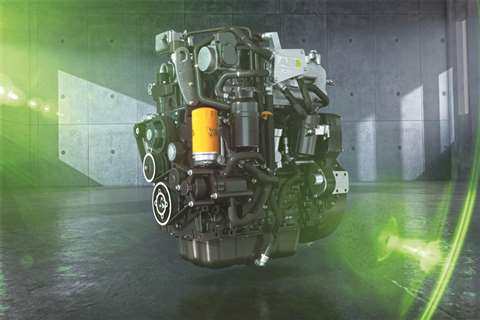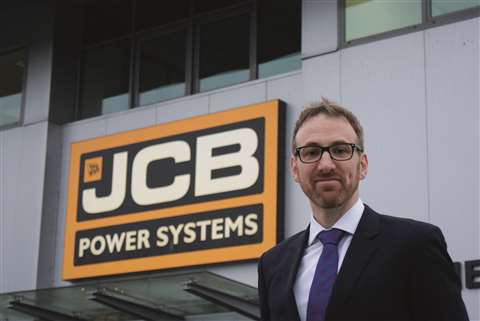Sustainable power in construction
08 June 2022
While modern diesel engines are efficient and clean, the road to zero emissions may lead to their demise, reports Mike Hayes.
At the recent Advanced Clean Transportation Expo in California, US, the CEO of engine maker Cummins Tom Linebarger commented on the dominant future technology for the industry.
 The new generation15 litre ‘agnostic’ engine from Cummins, capable of running on diesel/bio-fuel, natural gas and hydrogen. (Photo: Cummins)
The new generation15 litre ‘agnostic’ engine from Cummins, capable of running on diesel/bio-fuel, natural gas and hydrogen. (Photo: Cummins)
“Batteries will win out for passenger cars – hands down,” he predicted. “Hydrogen looks like a better fit for mining trucks…fuel cells are advancing quickly. But hydrogen as a combustible fuel might be more viable soon. But we don’t know. We are advancing all of these technologies at the same time.”
As things stand, this sounds like good sense as, with developments in both hydrogen and battery electric power technology moving at such a pace, it would probably be unwise for a major manufacturer to jump one way or the other just yet.
Hydrogen combustion engines
This is not just about which power solution is the best, it’s also about which power solution receives the most support from the industry, is seen as the most politically expedient, can sell itself on being the cheapest, the most sustainable, and so on.
With these variables in mind, Cummins has recently been investing in a range of technologies – from clean diesel to renewable fuels, from battery electric to hydrogen fuel cells.
To this end, the company has established a number of joint ventures and made acquisitions including the electric tech firms Brammo and Johnson Matthey Battery Systems, and hydrogen tech specialist Hydrogenics.
Cummins also recently announced the development of hydrogen combustion engines, a solution more aligned with its current machine designs and with the additional benefits of reduced complexity and the reuse of appropriate components for equipment manufacturers.
On the subject of components, Cummins has announced an investment in the powertrain components specialist Meritor, partly with a view to accelerating its development of electrified power solutions.
Constructions move away from diesel
Steve Nendick, marketing communications director at Cummins in the UK, recognises, however, that moving away from diesel engines won’t happen quickly – and he sees a more gradual shift as a necessary thing.
 Steve Nendick, marketing communications director at Cummins. (Photo: Cummins)
Steve Nendick, marketing communications director at Cummins. (Photo: Cummins)
“If you look at the diesel emissions standards we have now, it’s taken us 20 years to get from Stage I to Stage 5. The EU [in Europe] and the EPA [Environmental Protection Agency] in the US, recognised that the technology wasn’t available to go from one to five overnight, so we’ve done it in stages.
“I think that’s the mindset that’s needed in decarbonisation – to impact CO2 in a step-phase – because you can’t jump to zero overnight.”
He adds, “The next generation of diesel engines will be able to use diesel, hydrogen and natural gas. We’ve developed what we call an ‘agnostic engine’. Below the cylinder head, it essentially shares a lot of the key components, but the cylinder head and fuel system is then tailored to which fuel you use.”
Nendick is adamant that, given the variables of duty cycle and size and type of machine found in construction, there cannot currently be a ‘one-size-fits-all’ solution.
He says, “We’re investing in knowledge and capability in all solutions, including battery power and in hydrogen.
“Our aim is to be the power supplier of the future – whatever power source becomes the leading edge for the off-highway industry, Cummins will have a solution.
“The challenge that gives,” he adds, “is that it all needs investment – where local and national governments, and major organisations will invest money in infrastructure. That’s the tough decision going forward.”
The first hydrogen motor in construction
Construction equipment manufacturer JCB has travelled down a similar road on its journey towards a genuine diesel alternative. However, perhaps more than most of its peers in the construction industry, the British company has focused its development efforts towards hydrogen.
 JCB says its hydrogen engine was developed using established engine technology and components, combusting hydrogen just as a diesel engine does. (Photo: JCB)
JCB says its hydrogen engine was developed using established engine technology and components, combusting hydrogen just as a diesel engine does. (Photo: JCB)
JCB announced the first hydrogen motor in the industry, adapting its established engine technology with readily available components, to combust hydrogen and deliver power in the same way as a diesel engine.
Of course, the big sell – as opposed to cell – with this technology is that without carbon in the fuel, the output is just steam, resulting in a zero CO2 engine.
Daniel Jackson, OEM engine sales and applications manager for JCB Power Systems, says, “While the route is clear in the automotive [market], with electrification being a workable solution, it isn’t necessarily the complete solution for off-highway.
The limitations of sustainable power in construction
“We’ve had numerous launches of battery- electric products, and they sit well within a particular power range. We’re seeing that compact machines lend themselves to battery-electric [power]. With lower duty cycles and lower usage time, they lend themselves to these battery applications.
“We realise though that, as you try and scale up within our product range, you hit the limitation of the technology.”
Jackson offers the hypothetical example of a 20-tonne excavator, which may be required to service haulers continuously over an eight-hour shift or longer.
A machine like this, he says, might potentially need eight tonnes of batteries to fulfil its duty cycle requirements – and when would it be recharged?
Jackson says, “We’ve started to see the realisation of the options within hydrogen in general terms, about not only supplying the construction and agricultural equipment industry, but many other industries with potential power.
“While you’re developing wind farms, for example, to produce green energy, green electricity, now they can also be producing hydrogen through electrolysis and storing energy for peak times. It’s a much bigger picture than just looking at what is the fuel source for the off-highway market – it’s actually a much broader spectrum view of how we decarbonise all that we do.
 Daniel Jackson, OEM engine sales and applications manager for JCB Power Systems. (Photo: JCB)
Daniel Jackson, OEM engine sales and applications manager for JCB Power Systems. (Photo: JCB)
He adds, “Even as we’ve proven out the base principles of the [hydrogen] engine – talking about having a range of power nodes, having the same efficiency within the same size of engine, etc – it will take time to get there, so we’re developing hand-in-hand with the parts suppliers, the component suppliers…things like lubricants need to be developed, because you’re now effectively dealing with a steam engine; you potentially have high emulsification, so the oils need to deal with that.”
Battery powered equipment
One equipment manufacturer keen to look more closely at battery technology is John Deere. Its Power Systems division (JDPS), seeing the cost of the technology decreasing and the charging infrastructure growing, moved to acquire majority ownership of the Austrian electrification specialist Kreisel Electric, which develops high-density, high-durability electric battery modules and packs.
The company has also developed a charging infrastructure platform specifically for this patented battery technology.
JDPS believes that, utilising Kreisel’s technology, it can bring together higher energy density, durability, thermal management and integrated software that will allow for the heavier duty cycle of construction equipment.
Jennifer Preston, global director John Deere Electric Powertrain, said, “We are heavily investing in this opportunity to provide our customers with differentiated solutions that will ultimately help increase their productivity and profitability while providing them with the best possible user experience.”
Current solutions for off-road power go beyond hydrogen and battery electric, but these diesel alternative technologies are without doubt the frontrunners for the foreseeable future.
Is construction ready for electric equipment?
The infrastructure for battery charging is already changing the face of the automotive industry, and new gigafactories for battery manufacture are springing up across the world to meet the huge demand.
A similar roadmap for the electrification of construction equipment is clearly an option, but the technology does not currently lend itself easily to the duty cycles of heavier equipment.
For hydrogen to succeed, questions over whether hydrogen fuel cells (powered by electricity) or hydrogen-fuelled engines are the answer will need to be clarified.
The overarching challenge for both of these technologies, of course, is infrastructure. With this in mind, it’s hardly surprising that contractors are uncertain about how they should move away from diesel – and that’s a concern for an industry more willing than ever to ‘go green’.
STAY CONNECTED



Receive the information you need when you need it through our world-leading magazines, newsletters and daily briefings.
CONNECT WITH THE TEAM








